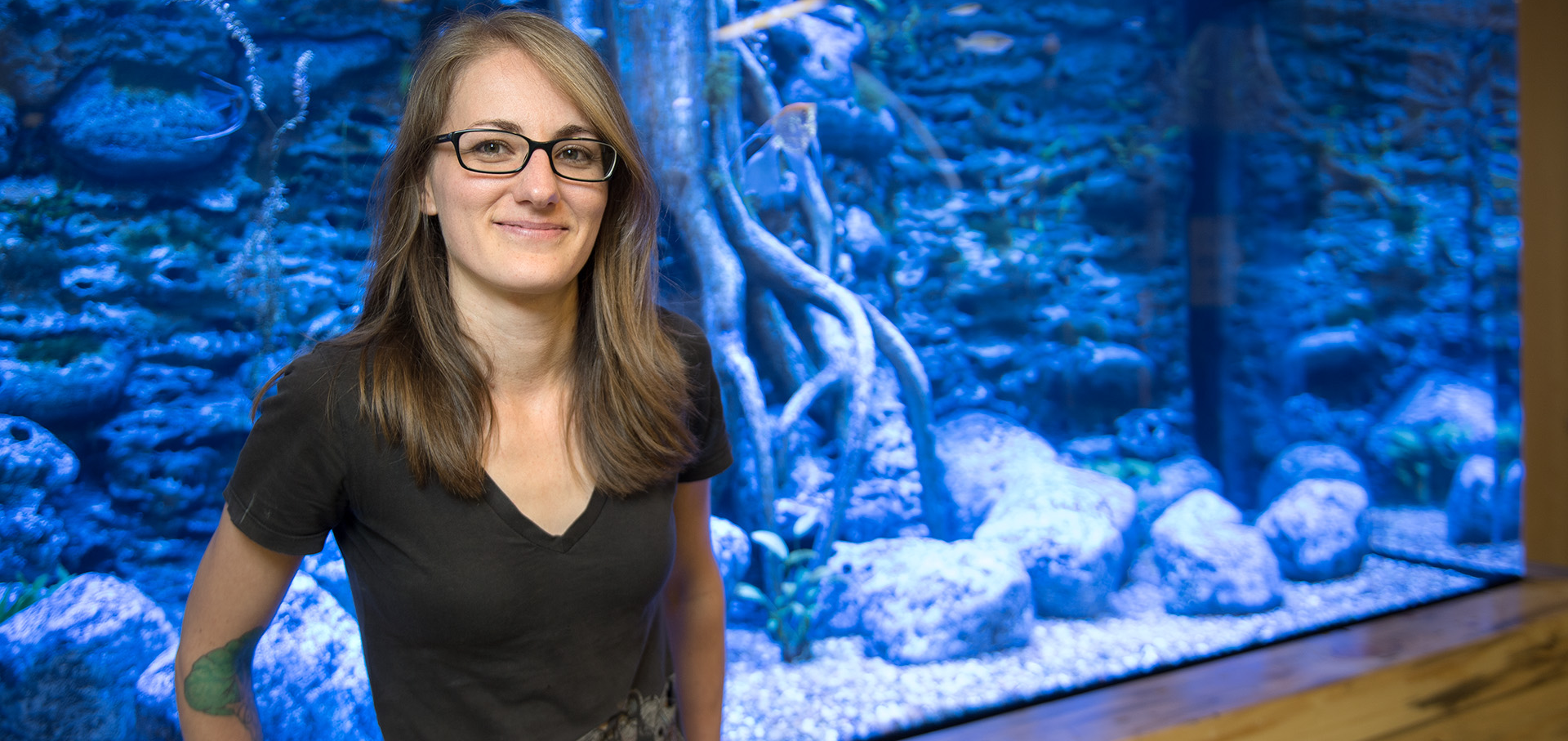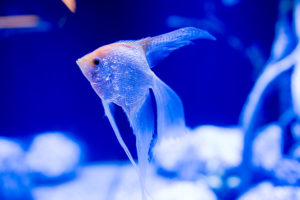
It all started with two pet guppies. Now Porsche Robison, a master’s student in the Department of Biology, is the lead caretaker for the Biology Building’s three massive lobby aquariums – as well as other tanks throughout the building.
“I’ve always been interested in fish,” said Robison, who obtained undergraduate degrees in music education and jazz studies at Long Island University in New York before coming to Colorado State University to get her biological science bachelors – which led into a masters.
After studying and caring for fish for more than two decades, she has a large-scale arena in which to help create beautiful and thriving ecosystems for the public that are also instructive – complementing the goals of the other displays in the new building. “I would like people to see natural behaviors of fish,” she said. And the building’s large tanks are especially well suited to fostering interactions like these, which are often absent from smaller tanks.
Like wild ecosystems, these cultivated environments offer lessons large and small to experts and novices alike. Specifically, Robison is curating the aquariums, which consist of a 1,300-gallon saltwater tank, a 400-gallon saltwater tank and an 850-gallon freshwater tank, to showcase distinct aquatic communities. The largest saltwater tank is built around the theme of a coral reef. The smaller saltwater tank is being groomed as a seahorse tank. And the freshwater tank features numerous plants and unusual fish, including the department’s very own spirited “ram cichlid.”
Diving in
The aquariums were years in the making even before the building opened in 2017. And Robison got involved from the beginning. Her part-time job at the time was managing a fish store, and when the department put out a call for input, she jumped at the opportunity to help shape the plans for the tanks.
The aquariums were initially managed by an outside contractor, but when the ecosystems looked to be struggling, the department turned management over to Robison. The new assignment came in February, precisely on her birthday. “I couldn’t have asked for a better birthday present,” she told Professor Joe von Fischer, the department’s associate chair, when he offered her the job.
 Of course, few birthday presents come with such hard work in tow. But Robison had the knowhow – and the grit – to take it on. She didn’t want to drain the tanks and start over because the populations of beneficial bacterial take a long time to become established. Instead, she opted for full water changes on each tank every week and embarked on scrubbing the aquariums’ hardscape of overabundant algae. “I pulled out every rock one-by-one and sat on top of the tanks with a bucket of salt water and a toothbrush and scrubbed,” she said. “It took about five weeks, but it was worth it.”
Of course, few birthday presents come with such hard work in tow. But Robison had the knowhow – and the grit – to take it on. She didn’t want to drain the tanks and start over because the populations of beneficial bacterial take a long time to become established. Instead, she opted for full water changes on each tank every week and embarked on scrubbing the aquariums’ hardscape of overabundant algae. “I pulled out every rock one-by-one and sat on top of the tanks with a bucket of salt water and a toothbrush and scrubbed,” she said. “It took about five weeks, but it was worth it.”
Now that the aquariums are stable, Robison is in the process of carefully adding new organisms, often with weeks between introductions to monitor the changes. And the newcomers don’t always make a splash with the viewing public. “I tend to stock fish last,” she said. “I’ve been focusing on invertebrates, so I’ve been adding hundreds of snails and crabs.” These humble inhabitants do a lot of the dirty work of keeping the water habitable for fish by taking in any excess food, breaking down waste and eating algae. Few people notice these crucial maintenance workers, but Robinson knows that they are vital to the long-term health of the tanks.
Next on her list are more seahorses and pipefish in the smaller saltwater tank and more schooling fish and bottom dwellers in the large saltwater tank – “it would be cool to see them exhibiting their natural behaviors,” she said.
Hooked on fish
When Robison was growing up in Santa Fe, New Mexico, her mom bought her her first fish tank, into which they introduced a couple of guppies. “They reproduced like crazy,” she said. Guppies have live births, which fascinated Robison and her sister. “That kind of hooked me on fish,” she said. “Then I went on a beta fish craze. But it wasn’t until I moved out and purchased a home that I started getting into large aquaria and large fish.” Her current favorites are South American cichlids (a group that includes the ram cichlid), which can get quite sizable. By now, she said, “I’ve kind of filled my home up with large aquaria.”
Robison’s full house has been a boon to the biology department – especially when it comes to pricey acquisitions such as live corals, which can run hundreds of dollars apiece. “I’ve been lucky enough to have an overabundance of coral in my life,” she said. “So a lot of my own personal livestock has been put into these tanks. It’s kept our purchasing price down – and I get to see some of my own work.” The saltwater tanks currently have more than 10 different species of live coral – as well as colorful anemones and some surprisingly charismatic clams – dotting the rocks.
Robison came full circle from her childhood entry into ichthyology when she began her research in the College of Natural Sciences. She landed in the lab of Professor Cameron Ghalambor, where they study adaptive evolution of guppies. And she is currently completing her master’s thesis on variation in parasitic worm infections in different wild populations of Trinidadian guppies.
School of fish
Once the Biology Building aquariums are full of fish and thriving, Robison has an even more expansive goal: not just bringing students to the tanks, but also bringing tanks to the students. She hopes to develop a program using smaller portable tanks to take specimens into classrooms for close-up instruction and observation.
Robison finishes her master’s this month, after which, she won’t be migrating far. She has landed a full-time job as the aquatics manager for CSU’s Lab Animal Resources, which is run through the Office of the Vice President for Research. In that role, she will be overseeing all tanks on campus – a far-reaching task, which she is eager to take on.
Although her aquatic charges will be multiplying, she will maintain her work – and connection – with the Biology Building tanks. Especially with the vlamingi, a tropical saltwater fish that possesses a powerful venom in its dorsal fin. “He’s my favorite,” she said. “He’s very personable.”
The Biology Building lobby aquariums are funded by the Department of Biology.